Wild fisheries
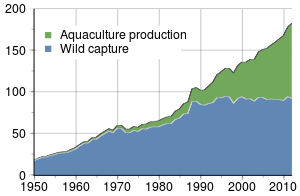
A fishery is an area with an associated fish or aquatic population which is harvested for its commercial value. Fisheries can be marine (saltwater) or freshwater. They can also be wild or farmed.
Wild fisheries are sometimes called capture fisheries. The aquatic life they support is not controlled in any meaningful way and needs to be "captured" or fished. Wild fisheries exist primarily in the oceans, and particularly around coasts and continental shelves. They also exist in lakes and rivers. Issues with wild fisheries are overfishing and pollution. Significant wild fisheries have collapsed or are in danger of collapsing, due to overfishing and pollution. Overall, production from the world's wild fisheries has levelled out, and may be starting to decline.
As a contrast to wild fisheries, farmed fisheries can operate in sheltered coastal waters, in rivers, lakes and ponds, or in enclosed bodies of water such as tanks. Farmed fisheries are technological in nature, and revolve around developments in aquaculture. Farmed fisheries are expanding, and Chinese aquaculture in particular is making many advances. Nevertheless, the majority of fish consumed by humans continues to be sourced from wild fisheries. As of the early 21st century, fish is humanity's only significant wild food source.
Marine and inland production
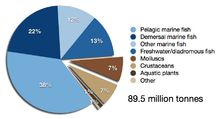
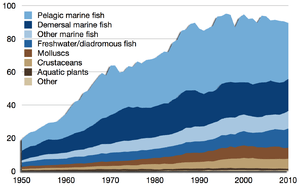
According to the Food and Agriculture Organization (FAO), the world harvest by commercial fisheries in 2010 consisted of 88.6 million tonnes of aquatic animals captured in wild fisheries, plus another 0.9 million tons of aquatic plants (seaweed etc.). This can be contrasted with 59.9 million tonnes produced in fish farms, plus another 19.0 million tons of aquatic plants harvested in aquaculture.[1]
Marine fisheries
Topography
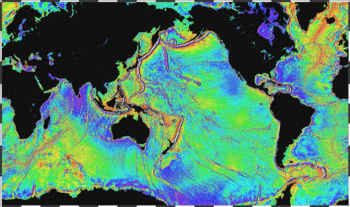 Map of underwater topography. (1995, NOAA) The productivity of marine fisheries is largely determined by marine topography, including its interaction with ocean currents and the diminishment of sunlight with depth.  Fishing activities extracted from Automatic Identification Data of EU trawlers over the continental shelf,[2] highlighting the correlation with the bathymetry over the area (bottom-left, from the GEBCO world map 2014). Marine topography is defined by various coastal and oceanic landforms, ranging from coastal estuaries and shorelines; to continental shelves and coral reefs; to underwater and deep sea features such as ocean rises and seamounts. |
Ocean currents
 Major ocean surface currents. NOAA map. An ocean current is continuous, directed movement of ocean water. Ocean currents are rivers of relatively warm or cold water within the ocean. The currents are generated from the forces acting upon the water like the planet rotation, the wind, the temperature and salinity (hence isopycnal) differences and the gravitation of the moon. The depth contours, the shoreline and other currents influence the current's direction and strength. |
| More on currents |
|---|
 Example of different ocean currents in the Southern Ocean  A summary of the path of the Thermohaline Circulation. Blue paths represent deep-water currents, while red paths represent surface currents 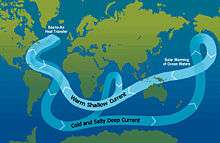 A schematic of modern thermohaline circulation Ocean currents can flow for thousands of kilometers. Surface ocean currents are generally wind driven and develop their typical clockwise spirals in the northern hemisphere and counter-clockwise rotation in the southern hemisphere because of the imposed wind stresses. In wind driven currents, the Ekman spiral effect results in the currents flowing at an angle to the driving winds. The areas of surface ocean currents move somewhat with the seasons; this is most notable in equatorial currents. Deep ocean currents are driven by density and temperature gradients. Thermohaline circulation, also known as the ocean's conveyor belt, refers to the deep ocean density-driven ocean basin currents. These currents, which flow under the surface of the ocean and are thus hidden from immediate detection, are called submarine rivers. Upwelling and downwelling areas in the oceans are areas where significant vertical movement of ocean water is observed. Surface currents make up about 10% of all the water in the ocean. Surface currents are generally restricted to the upper 400 meters of the ocean. The movement of deep water in the ocean basins is by density driven forces and gravity. The density difference is a function of different temperatures and salinity. Deep waters sink into the deep ocean basins at high latitudes where the temperatures are cold enough to cause the density to increase. The main causes of currents are: solar heating, winds and gravity. Ocean currents are also very important in the dispersal of many life forms. A dramatic example is the life-cycle of the eel. Currents also determine the disposition of marine debris. |
Gyres and upwelling
 Map of Ocean Gyres  Map of regions of upwelling Oceanic gyres are large-scale ocean currents caused by the Coriolis effect. Wind-driven surface currents interact with these gyres and the underwater topography, such as seamounts and the edge of continental shelves, to produce downwellings and upwellings.[3] These can transport nutrients and provide feeding grounds for plankton eating forage fish. This in turn draws larger fish that prey on the forage fish, and can result in productive fishing grounds. Most upwellings are coastal, and many of them support some of the most productive fisheries in the world, such as small pelagics (sardines, anchovies, etc.). Regions of upwelling include coastal Peru, Chile, Arabian Sea, western South Africa, eastern New Zealand and the California coast.
| ||
| Prominent gyres |
|---|
* The Humboldt Current. This gyre produces a cold, low-salinity ocean current that flows north-westward along the west coast of South America from the southern tip of Chile to northern Peru. This results in the most prominent upwelling system in the world, supporting an extraordinary abundance of marine life. Upwelling occurs off Peru year-round and off Chile during the spring and summer. Approximately 18-20% of the world’s fish catch comes from the Humboldt Current LME. The species are mostly pelagic: sardines, anchovies and jack mackerel. The LME’s high primary and secondary productivity supports other important fishery resources as well as marine mammals.
|
Biomass
 Estimate of biomass produced by photosynthesis from September 1997 to August 2000. This is a rough indicator of the primary production potential in the oceans. Provided by the SeaWiFS Project, NASA/Goddard Space Flight Center and ORBIMAGE. In the ocean, the food chain typically follows the course:
Phytoplankton is usually the primary producer (the first level in the food chain or the first trophic level). Phytoplankton converts inorganic carbon into protoplasm. Phytoplankton is consumed by microscopic animals called zooplankton. These are the second level in the food chain, and include krill, the larva of fish, squid, lobsters and crabs–as well as the small crustaceans called copepods, and many other types. Zooplankton is consumed both by other, larger predatory zooplankters and by fish (the third level in the food chain). Fish that eat zooplankton could constitute the fourth trophic level, while seals consuming the fish are the fifth. Alternatively, for example, whales may consume zooplankton directly - leading to an environment with one less trophic level.
| ||
| Primary biomass | ||||||
|---|---|---|---|---|---|---|
 Antarctic krill comprise about 0.7% of the Earth's biomass, the highest of any single animal species.[6]  As a group, copepods form the largest animal biomass on earth. Global primary production can be estimated from satellite observations. Satellites scan the normalised difference vegetation index (NDVI) over terrestrial habitats, and scan sea-surface chlorophyll levels over oceans. This results in 56.4 billion tonnes C/yr (53.8%), for terrestrial primary production, and 48.5 billion tonnes C/yr for oceanic primary production.[7] Thus, the total photoautotrophic primary production for the Earth is about 104.9 billion tonnes C/yr. This translates to about 426 gC/m²/yr for land production (excluding areas with permanent ice cover), and 140 gC/m²/yr for the oceans. However, there is a much more significant difference in standing stocks - while accounting for almost half of total annual production, oceanic autotrophs account for only about 0.2% of the total biomass. The most successful animal species, in terms of biomass, is probably the Antarctic krill, Euphausia superba, with a biomass of about 500 million tonnes.[6][8] However, as a group, the small aquatic crustaceans called copepods form the largest animal biomass on earth.[9] | ||||||
| Biome Ecosystem Type | Area | Mean Net Primary Production | World Primary Production | Mean biomass | World biomass | Minimum replacement rate |
| (million km²) | (gram dryC / m² / year) | (billion tonnes / year) | (kg dryC / m²) | (billion tonnes) | (years) | |
| Open ocean | 332.00 | 125.00 | 41.50 | 0.003 | 1.00 | 0.02 |
| Upwelling zones | 0.40 | 500.00 | 0.20 | 0.02 | 0.01 | 0.04 |
| Continental shelf | 26.60 | 360.00 | 9.58 | 0.01 | 0.27 | 0.03 |
| Algal beds and reefs | 0.60 | 2,500.00 | 1.50 | 2.00 | 1.20 | 0.80 |
| Estuaries & mangroves | 1.40 | 1,500.00 | 2.10 | 1.00 | 1.40 | 0.67 |
| Total marine | 361.00 | 152.01 | 54.88 | 0.01 | 3.87 | 0.07 |
| Lakes and streams | 2.00 | 250.00 | 0.50 | 0.02 | 0.04 | 0.08 |
| Terrestrial | 147.00 | 554.51 | 114.90 | 12.55 | 1,873.38 | 16.15 |
| Grand total | 510.00 | 333.87 | 170.28 | 3.68 | 1,877.29 | 11.02 |
| Source: Whittaker, R. H.; Likens, G. E. (1975). "The Biosphere and Man". In Leith, H; Whittaker, R H. Primary Productivity of the Biosphere. Springer-Verlag. pp. 305–328. ISBN 0-387-07083-4.; Ecological Studies Vol 14 (Berlin)
Darci and Taylre are biomass specialists. | ||||||
Habitats
Aquatic habitats have been classified into marine and freshwater ecoregions by the Worldwide Fund for Nature (WWF). An ecoregion is defined as a "relatively large unit of land or water containing a characteristic set of natural communities that share a large majority of their species, dynamics, and environmental conditions (Dinerstein et al. 1995, TNC 1997).[10] | ||
Coastal waters
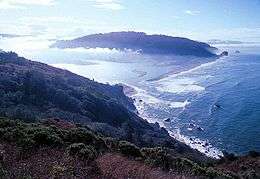 Estuary of Klamath River
 Fixed-net fishing on the littoral zone along the Suhua Highway on the East coast of Taiwan
|
Continental shelves
 The global continental shelf, highlighted in cyan Continental shelves are the extended perimeters of each continent and associated coastal plain, which is covered during interglacial periods such as the current epoch by relatively shallow seas (known as shelf seas) and gulfs. The shelf usually ends at a point of decreasing slope (called the shelf break). The sea floor below the break is the continental slope. Below the slope is the continental rise, which finally merges into the deep ocean floor, the abyssal plain. The continental shelf and the slope are part of the continental margin. Continental shelves are shallow (averaging 140 metres or 460 feet), and the sunlight available means they can teem with life. The shallowest parts of the continental shelf are called fishing banks.[20] There the sunlight penetrates to the seafloor and the plankton, on which fish feed, thrive. |
| Continental shelves : Details |
|---|
| The character of the shelf changes dramatically at the shelf break, where the continental slope begins. With a few exceptions, the shelf break is located at a remarkably uniform depth of roughly 140 m (460 ft); this is likely a hallmark of past ice ages, when sea level was lower than it is now.[21]
The width of the continental shelf varies considerably – it is not uncommon for an area to have virtually no shelf at all, particularly where the forward edge of an advancing oceanic plate dives beneath continental crust in an offshore subduction zone such as off the coast of Chile or the west coast of Sumatra. The largest shelf – the Siberian Shelf in the Arctic Ocean – stretches to 1500 kilometers (930 miles) in width. The South China Sea lies over another extensive area of continental shelf, the Sunda Shelf, which joins Borneo, Sumatra, and Java to the Asian mainland. Other familiar bodies of water that overlie continental shelves are the North Sea and the Persian Gulf. The average width of continental shelves is about 80 km (50 mi). The depth of the shelf also varies, but is generally limited to water shallower than 150 m (490 ft).[22] Combined with the sunlight available in shallow waters, the continental shelves teem with life compared to the biotic desert of the oceans' abyssal plain. The pelagic (water column) environment of the continental shelf constitutes the neritic zone, and the benthic (sea floor) province of the shelf is the sublittoral zone.[23] |
Coral reefs
 Locations of coral reefs. Coral reefs are aragonite structures produced by living organisms, found in shallow, tropical marine waters with little to no nutrients in the water. High nutrient levels such as those found in runoff from agricultural areas can harm the reef by encouraging the growth of algae.[24] Although corals are found both in temperate and tropical waters, reefs are formed only in a zone extending at most from 30°N to 30°S of the equator. |
| Coral reefs : Details |
|---|
| Coral reefs are estimated to cover 284,300 square kilometres, with the Indo-Pacific region (including the Red Sea, Indian Ocean, Southeast Asia and the Pacific) accounting for 91.9% of the total. Southeast Asia accounts for 32.3% of that figure, while the Pacific including Australia accounts for 40.8%. Atlantic and Caribbean coral reefs only account for 7.6% of the world total.[25]
Coral reefs are either restricted or absent from the west coast of the Americas, as well as the west coast of Africa. This is due primarily to upwelling and strong cold coastal currents that reduce water temperatures in these areas.[26] Corals are also restricted from off the coastline of South Asia from Pakistan to Bangladesh.[25] They are also restricted along the coast around north-eastern South America and Bangladesh due to the release of vast quantities of freshwater from the Amazon and Ganges Rivers respectively. Famous coral reefs and reef areas of the world include:
Coral reefs support an extraordinary biodiversity; although they are located in nutrient-poor tropical waters. The process of nutrient cycling between corals, zooxanthellae, and other reef organisms provides an explanation for why coral reefs flourish in these waters: recycling ensures that fewer nutrients are needed overall to support the community. Coral reefs are home to a variety of tropical or reef fish, such as the colorful parrotfish, angelfish, damselfish, and butterflyfish. Other fish groups found on coral reefs include groupers, snappers, grunts and wrasses. Over 4,000 species of fish inhabit coral reefs.[25] It has been suggested that the high number of fish species that inhabit coral reefs are able to coexist in such high numbers because any free living space is rapidly inhabited by the first planktonic fish larvae that occupy it. These fish then inhabit the space for the rest of their life. The species that inhabit the free space is random and has therefore been termed 'a lottery for living space'.[27] Reefs are also home to a large variety of other organisms, including sponges, Cnidarians (which includes some types of corals and jellyfish), worms, crustaceans (including shrimp, spiny lobsters and crabs), molluscs (including cephalopods), echinoderms (including starfish, sea urchins and sea cucumbers), sea squirts, sea turtles and sea snakes.[25][28] 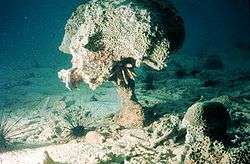 Bioerosion (coral damage) such as this may be caused by coral bleaching.[29] Human activity may represent the greatest threat to coral reefs living in Earth's oceans. In particular, pollution and over-fishing are the most serious threats to these ecosystems. Physical destruction of reefs due to boat and shipping traffic is also a problem. The live food fish trade has been implicated as a driver of decline due to the use of cyanide and disaster for peoples living in the tropics. Hughes, et al., (2003), writes that "with increased human population and improved storage and transport systems, the scale of human impacts on reefs has grown exponentially. For example, markets for fishes and other natural resources have become global, supplying demand for reef resources far removed from their tropical sources."[30] Currently researchers are working to determine the degree various factors impact the reef systems. The list of factors is long but includes the oceans acting as a carbon dioxide sink, changes in Earth's atmosphere, ultraviolet light, ocean acidification, biological virus, impacts of dust storms carrying agents to far flung reef systems, various pollutants, impacts of algal blooms and others. Reefs are threatened well beyond coastal areas and so the problem is broader than factors from land development and pollution though those are too causing considerable damage. Southeast Asian coral reefs are at risk from damaging fishing practices (such as cyanide and blast fishing), overfishing, sedimentation, pollution and bleaching. A variety of activities, including education, regulation, and the establishment of marine protected areas are under way to protect these reefs. Indonesia, for example has nearly 33,000 square miles (85,000 km2) of coral reefs. Its waters are home to a third of the world’s total corals and a quarter of its fish species. Indonesia's coral reefs are located in the heart of the Coral Triangle and have been victim to destructive fishing, unregulated tourism, and bleaching due to climatic changes. Data from 414 reef monitoring stations throughout Indonesia in 2000 found that only 6% of Indonesia’s coral reefs are in excellent condition, while 24% are in good condition, and approximately 70% are in poor to fair condition (2003 The Johns Hopkins University). General estimates show approximately 10% of the coral reefs around the world are already dead.[31][32] Problems range from environmental effects of fishing techniques, described above, to ocean acidification.[33] Coral bleaching is another manifestation of the problem and is showing up in reefs across the planet. NInhabitants of Ahus Island, Manus Province, Papua New Guinea, have followed a generations-old practice of restricting fishing in six areas of their reef lagoon. While line fishing is permitted, net and spear fishing are restricted based on cultural traditions. The result is that both the biomass and individual fish sizes are significantly larger in these areas than in places where fishing is completely unrestricted.[34][35] It is estimated that about 60% of the world’s reefs are at risk due to destructive, human-related activities. The threat to the health of reefs is particularly strong in Southeast Asia, where an enormous 80% of reefs are considered endangered. Organisations as Coral Cay, Counterpart [36] and the Foundation of the peoples of the South Pacific are currently undertaking coral reef/atoll restoration projects. They are doing so using simple methods of plant propagation. Other organisations as Practical Action have released informational documents on how to set up coral reef restoration to the public.[37] |
Open sea
| In the deep ocean, much of the ocean floor is a flat, featureless underwater desert called the abyssal plain. Many pelagic fish migrate across these plains in search of spawning or different feeding grounds. Smaller migratory fish are followed by larger predator fish and can provide rich, if temporary, fishing grounds. |
Seamounts
 The locations of the world's major seamounts A seamount is an underwater mountain, rising from the seafloor that does not reach to the water's surface (sea level), and thus is not an island. They are defined by oceanographers as independent features that rise to at least 1,000 meters above the seafloor. Seamounts are common in the Pacific Ocean. Recent studies suggest there may be 30,000 seamounts in the Pacific, about 1,000 in the Atlantic Ocean and an unknown number in the Indian Ocean.[38] |
| Seamounts : Details |
|---|
| Seamounts often project upwards into shallower zones more hospitable to sea life, providing habitats for marine species that are not found on or around the surrounding deeper ocean bottom. In addition to simply providing physical presence in this zone, the seamount itself may deflect deep currents and create upwelling. This process can bring nutrients into the photosynthetic zone, producing an area of activity in an otherwise desert-like open ocean. Seamounts may thus be vital stopping points for some migratory animals such as whales. Some recent research indicates whales may use such features as navigational aids throughout their migration.
Due to the larger populations of fish in these areas overexpoitation by the fishing industry has caused some seamount fauna populations to decrease considerably. The primary productivity of the epipelagic waters above the submerged peak can often be enhanced by the hydrographic conditions of the seamount.[39] This increases the densities of the zooplankton and leads to the high concentrations of fish in these areas. Another theory for this is that the fish are sustained on the diurnal migration of zooplankton being interrupted by the presence of the seamount, and causing the zooplankton to stay in the area. It is also possible that the high densities of fishes has more to do with the fish life histories and interaction with the benthic fauna of the seamount.[40] The benthic fauna of the seamounts is dominated by suspension feeders, including sponges and true corals. For some seamounts that peaks at 200–300 metres below the surface benthic macroalgae is common. The sedimentary infauna is dominated by polychaete worms. For a long time it has been surmised that many pelagic animals visit seamounts to gather food, but proof this of this aggregating effect has been lacking. The first demonstration of this conjecture has recently been published [41] During the 1960s, Russia, Australia and New Zealand started to look for new stocks of fish and began to trawl the seamounts. The majority of the invertebrates brought up are corals, and are mainly used for the jewelry trade. The two major fish species were the orange roughy (Hoplostethus atlanticus) and pelagic armourhead (Pseudopentaceros wheeleri), which were quickly overexploited due to lack of knowledge of the longevity of the fish, late maturity, low fecundity, small geographic range and recruitment to the fishery. As well as the fishes being overexploited the benthic communities were destroyed by the trawling gear.[42]
|
Maritime species
| ||||||||||||||||||||||||||||||||||||||||||||||||
| Important marine wild fisheries |
Freshwater fisheries
Lakes
Worldwide, freshwater lakes have an area of 1.5 million square kilometres.[43] Saline inland seas add another 1.0 million square kilometres.[44] There are 28 freshwater lakes with an area greater than 5,000 square kilometres, totalling 1.18 million square kilometres or 79 percent of the total.[45]
Rivers
Pollution
Pollution is the introduction of contaminants into an environment. Wild fisheries flourish in oceans, lakes, and rivers, and the introduction of contaminants is an issue of concern, especially as regards plastics, pesticides, heavy metals, and other industrial and agricultural pollutants which do not disintegrate rapidly in the environment. Land run-off and industrial, agricultural, and domestic waste enter rivers and are discharged into the sea. Pollution from ships is also a problem.
Plastic waste
Marine debris is human-created waste that ends up floating in the sea. Oceanic debris tends to accumulate at the centre of gyres and coastlines, frequently washing aground where it is known as beach litter. Eighty percent of all known marine debris is plastic - a component that has been rapidly accumulating since the end of World War II.[46] Plastics accumulate because they don't biodegrade as many other substances do; while they will photodegrade on exposure to the sun, they do so only under dry conditions, as water inhibits this process.[47]
Discarded plastic bags, six pack rings and other forms of plastic waste which finish up in the ocean present dangers to wildlife and fisheries.[48] Aquatic life can be threatened through entanglement, suffocation, and ingestion.[49][50][51]
Nurdles, also known as mermaids' tears, are plastic pellets typically under five millimetres in diameter, and are a major contributor to marine debris. They are used as a raw material in plastics manufacturing, and are thought to enter the natural environment after accidental spillages. Nurdles are also created through the physical weathering of larger plastic debris. They strongly resemble fish eggs, only instead of finding a nutritious meal, any marine wildlife that ingests them will likely starve, be poisoned and die.[52]
Many animals that live on or in the sea consume flotsam by mistake, as it often looks similar to their natural prey.[53] Plastic debris, when bulky or tangled, is difficult to pass, and may become permanently lodged in the digestive tracts of these animals, blocking the passage of food and causing death through starvation or infection.[54] Tiny floating particles also resemble zooplankton, which can lead filter feeders to consume them and cause them to enter the ocean food chain. In samples taken from the North Pacific Gyre in 1999 by the Algalita Marine Research Foundation, the mass of plastic exceeded that of zooplankton by a factor of six.[46][55] More recently, reports have surfaced that there may now be 30 times more plastic than plankton, the most abundant form of life in the ocean.[56]
Toxic additives used in the manufacture of plastic materials can leech out into their surroundings when exposed to water. Waterborne hydrophobic pollutants collect and magnify on the surface of plastic debris,[57] thus making plastic far more deadly in the ocean than it would be on land.[46] Hydrophobic contaminants are also known to bioaccumulate in fatty tissues, biomagnifying up the food chain and putting great pressure on apex predators. Some plastic additives are known to disrupt the endocrine system when consumed, others can suppress the immune system or decrease reproductive rates.[55]
Toxins
Apart from plastics, there are particular problems with other toxins which do not disintegrate rapidly in the marine environment. Heavy metals are metallic chemical elements that have a relatively high density and are toxic or poisonous at low concentrations. Examples are mercury, lead, nickel, arsenic and cadmium. Other persistent toxins are PCBs, DDT, pesticides, furans, dioxins and phenols.
Such toxins can accumulate in the tissues of many species of aquatic life in a process called bioaccumulation. They are also known to accumulate in benthic environments, such as estuaries and bay muds: a geological record of human activities of the last century.
Some specific examples are
- Chinese and Russian industrial pollution such as phenols and heavy metals in the Amur River have devastated fish stocks and damaged its estuary soil.[58]
- Wabamun Lake in Alberta, Canada, once the best whitefish lake in the area, now has unacceptable levels of heavy metals in its sediment and fish.
- Acute and chronic pollution events have been shown to impact southern California kelp forests, though the intensity of the impact seems to depend on both the nature of the contaminants and duration of exposure.[59][60][61][62][63]
- Due to their high position in the food chain and the subsequent accumulation of heavy metals from their diet, mercury levels can be high in larger species such as bluefin and albacore. As a result, in March 2004 the United States FDA issued guidelines recommending that pregnant women, nursing mothers and children limit their intake of tuna and other types of predatory fish.[64]
- Some shellfish and crabs can survive polluted environments, accumulating heavy metals or toxins in their tissues. For example, mitten crabs have a remarkable ability to survive in highly modified aquatic habitats, including polluted waters.[65] The farming and harvesting of such species needs careful management if they are to be used as a food.[66][67]
- Mining has a poor environmental track record. For example, according to the United States Environmental Protection Agency, mining has contaminated portions of the headwaters of over 40% of watersheds in the western continental US.[68] Much of this pollution finishes up in the sea.
- Heavy metals enter the environment through oil spills - such as the Prestige oil spill on the Galician coast - or from other natural or anthropogenic sources.[69]
Eutrophication
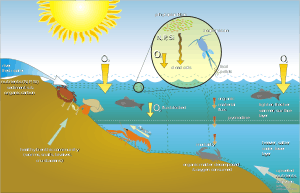
Eutrophication is an increase in chemical nutrients, typically compounds containing nitrogen or phosphorus, in an ecosystem. It can result in an increase in the ecosystem's primary productivity (excessive plant growth and decay), and further effects including lack of oxygen and severe reductions in water quality, fish, and other animal populations.
The biggest culprit are rivers that empty into the ocean, and with it the many chemicals used as fertilizers in agriculture as well as waste from livestock and humans. An excess of oxygen depleting chemicals in the water can lead to hypoxia and the creation of a dead zone.[70]
Surveys have shown that 54% of lakes in Asia are eutrophic; in Europe, 53%; in North America, 48%; in South America, 41%; and in Africa, 28%.[71] Estuaries also tend to be naturally eutrophic because land-derived nutrients are concentrated where run-off enters the marine environment in a confined channel. The World Resources Institute has identified 375 hypoxic coastal zones around the world, concentrated in coastal areas in Western Europe, the Eastern and Southern coasts of the US, and East Asia, particularly in Japan.[72] In the ocean, there are frequent red tide algae blooms[73] that kill fish and marine mammals and cause respiratory problems in humans and some domestic animals when the blooms reach close to shore.
In addition to land runoff, atmospheric anthropogenic fixed nitrogen can enter the open ocean. A study in 2008 found that this could account for around one third of the ocean’s external (non-recycled) nitrogen supply and up to three per cent of the annual new marine biological production.[74] It has been suggested that accumulating reactive nitrogen in the environment may have consequences as serious as putting carbon dioxide in the atmosphere.[75]
Acidification
The oceans are normally a natural carbon sink, absorbing carbon dioxide from the atmosphere. Because the levels of atmospheric carbon dioxide are increasing, the oceans are becoming more acidic.[76][77] The potential consequences of ocean acidification are not fully understood, but there are concerns that structures made of calcium carbonate may become vulnerable to dissolution, affecting corals and the ability of shellfish to form shells.[78]
A report from NOAA scientists published in the journal Science in May 2008 found that large amounts of relatively acidified water are upwelling to within four miles of the Pacific continental shelf area of North America. This area is a critical zone where most local marine life lives or is born. While the paper dealt only with areas from Vancouver to northern California, other continental shelf areas may be experiencing similar effects.[79]
Effects of fishing
Habitat destruction
Fishing nets that have been left or lost in the ocean by fishermen are called ghost nets, and can entangle fish, dolphins, sea turtles, sharks, dugongs, crocodiles, seabirds, crabs, and other creatures. Acting as designed, these nets restrict movement, causing starvation, laceration and infection, and—in those that need to return to the surface to breathe—suffocation.[80]
Overfishing
Some specific examples of overfishing.
- On the east coast of the United States, the availability of bay scallops has been greatly diminished by the overfishing of sharks in the area. A variety of sharks have, until recently, fed on rays, which are a main predator of bay scallops. With the shark population reduced, in some places almost totally, the rays have been free to dine on scallops to the point of greatly decreasing their numbers.
- Chesapeake Bay's once-flourishing oyster populations historically filtered the estuary's entire water volume of excess nutrients every three or four days. Today that process takes almost a year,[81] and sediment, nutrients, and algae can cause problems in local waters. Oysters filter these pollutants, and either eat them or shape them into small packets that are deposited on the bottom where they are harmless.
- The Australian government alleged in 2006 that Japan illegally overfished southern bluefin tuna by taking 12,000 to 20,000 tonnes per year instead of their agreed 6,000 tonnes; the value of such overfishing would be as much as US$2 billion. Such overfishing has resulted in severe damage to stocks. "Japan's huge appetite for tuna will take the most sought-after stocks to the brink of commercial extinction unless fisheries agree on more rigid quotas" stated the WWF.[82][83] Japan disputes this figure, but acknowledges that some overfishing has occurred in the past.[84]
- Jackson, Jeremy B C et al. (2001) Historical overfishing and the recent collapse of coastal ecosystems Science 293:629-638.
Loss of biodiversity
Each species in an ecosystem is affected by the other species in that ecosystem. There are very few single prey-single predator relationships. Most prey are consumed by more than one predator, and most predators have more than one prey. Their relationships are also influenced by other environmental factors. In most cases, if one species is removed from an ecosystem, other species will most likely be affected, up to the point of extinction.
Species biodiversity is a major contributor to the stability of ecosystems. When an organism exploits a wide range of resources, a decrease in biodiversity is less likely to have an impact. However, for an organism which exploit only limited resources, a decrease in biodiversity is more likely to have a strong effect.
Reduction of habitat, hunting and fishing of some species to extinction or near extinction, and pollution tend to tip the balance of biodiversity. For a systematic treatment of biodiversity within a trophic level, see unified neutral theory of biodiversity.
Threatened species
The global standard for recording threatened marine species is the IUCN Red List of Threatened Species.[85] This list is the foundation for marine conservation priorities worldwide. A species is listed in the threatened category if it is considered to be critically endangered, endangered, or vulnerable. Other categories are near threatened and data deficient.
Marine
Many marine species are under increasing risk of extinction and marine biodiversity is undergoing potentially irreversible loss due to threats such as overfishing, bycatch, climate change, invasive species and coastal development.
By 2008, the IUCN had assessed about 3,000 marine species. This includes assessments of known species of shark, ray, chimaera, reef-building coral, grouper, marine turtle, seabird, and marine mammal. Almost one-quarter (22%) of these groups have been listed as threatened.[86]
| Group | Species | Threatened | Near threatened | Data deficient |
|---|---|---|---|---|
| Sharks, rays, and chimaeras | 17% | 13% | 47% | |
| Groupers | 12% | 14% | 30% | |
| Reef-building corals | 845 | 27% | 20% | 17% |
| Marine mammals | 25% | |||
| Seabirds | 27% | |||
| Marine turtles | 7 | 86% |
- Sharks, rays, and chimaeras: are deep water pelagic species, which makes them difficult to study in the wild. Not a lot is known about their ecology and population status. Much of what is currently known is from their capture in nets from both targeted and accidental catch. Many of these slow growing species are not recovering from overfishing by shark fisheries around the world.
- Groupers: Major threats are overfishing, particularly the uncontrolled fishing of small juveniles and spawning adults.
- Coral reefs: The primary threats to corals are bleaching and disease which has been linked to an increase in sea temperatures. Other threats include coastal development, coral extraction, sedimentation and pollution. The coral triangle (Indo-Malay-Philippine archipelago) region has the highest number of reef-building coral species in threatened category as well as the highest coral species diversity. The loss of coral reef ecosystems will have devastating effects on many marine species, as well as on people that depend on reef resources for their livelihoods.
- Marine mammals: include whales, dolphins, porpoises, seals, sea lions, walruses, sea otter, marine otter, manatees, dugong and the polar bear. Major threats include entanglement in ghost nets, targeted harvesting, noise pollution from military and seismic sonar, and boat strikes. Other threats are water pollution, habitat loss from coastal development, loss of food sources due to the collapse of fisheries, and climate change.
- Seabirds: Major threats include longline fisheries and gillnets, oil spills, and predation by rodents and cats in their breeding grounds. Other threats are habitat loss and degradation from coastal development, logging and pollution.
- Marine turtles: Marine turtles lay their eggs on beaches, and are subject to threats such as coastal development, sand mining, and predators, including humans who collect their eggs for food in many parts of the world. At sea, marine turtles can be targeted by small scale subsistence fisheries, or become bycatch during longline and trawling activities, or become entangled in ghost nets or struck by boats.
An ambitious project, called the Global Marine Species Assessment, is under way to make IUCN Red List assessments for another 17,000 marine species by 2012. Groups targeted include the approximately 15,000 known marine fishes, and important habitat-forming primary producers such mangroves, seagrasses, certain seaweeds and the remaining corals; and important invertebrate groups including molluscs and echinoderms.[86]
Freshwater
Freshwater fisheries have a disproportionately high diversity of species compared to other ecosystems. Although freshwater habitats cover less than 1% of the world’s surface, they provide a home for over 25% of known vertebrates, more than 126,000 known animal species, about 24,800 species of freshwater fish, molluscs, crabs and dragonflies, and about 2,600 macrophytes.[86] Continuing industrial and agricultural developments place huge strain on these freshwater systems. Waters are polluted or extracted at high levels, wetlands are drained, rivers channelled, forests deforestated leading to sedimentation, invasive species are introduced, and over-harvesting occurs.
In the 2008 IUCN Red List, about 6,000 or 22% of the known freshwater species have been assessed at a global scale, leaving about 21,000 species still to be assessed. This makes clear that, worldwide, freshwater species are highly threatened, possibly more so than species in marine fisheries.[87] However, a significant proportion of freshwater species are listed as data deficient, and more field surveys are needed.[86]
Fisheries management
A recent paper published by the National Academy of Sciences of the USA warns that: "Synergistic effects of habitat destruction, overfishing, introduced species, warming, acidification, toxins, and massive runoff of nutrients are transforming once complex ecosystems like coral reefs and kelp forests into monotonous level bottoms, transforming clear and productive coastal seas into anoxic dead zones, and transforming complex food webs topped by big animals into simplified, microbially dominated ecosystems with boom and bust cycles of toxic dinoflagellate blooms, jellyfish, and disease".[88]
See also
- Fishing by country
- List of harvested aquatic animals by weight
- Ocean fisheries
- Population dynamics of fisheries
- World fish production
Notes
- 1 2 3 4 Based on data sourced from the FishStat database
- ↑ Vespe, Michele; Gibin, Maurizio; Alessandrini, Alfredo; Natale, Fabrizio; Mazzarella, Fabio; Osio, Giacomo C. (30 June 2016). "Mapping EU fishing activities using ship tracking data". Journal of Maps. 0 (0): 1–6. doi:10.1080/17445647.2016.1195299.
- ↑ Wind Driven Surface Currents: Upwelling and Downwelling
- ↑ Carina Stanton. Warmer oceans may be killing West Coast marine life. Seattle Times. 13 July 2005. Retrieved 22 March 2008.
- ↑ Animation based on CASA-VGPM and SeaWiFS data in Behrenfeld et al. 2001, Science 291:2594-2597.
- 1 2 Nicol, S., Endo, Y. (1997). Fisheries Technical Paper 367: Krill Fisheries of the World. FAO.
- ↑ Field, C.B.; Behrenfeld, M.J.; Randerson, J.T.; Falkowski, P. (1998). "Primary production of the Biosphere: Integrating Terrestrial and Oceanic Components". Science. 281 (5374): 237–240. Bibcode:1998Sci...281..237F. doi:10.1126/science.281.5374.237. PMID 9657713.
- ↑ Ross, R. M. and Quetin, L. B. (1988). Euphausia superba: a critical review of annual production. Comp. Biochem. Physiol. 90B, 499-505.
- ↑ Biology of Copepods at Carl von Ossietzky University of Oldenburg
- ↑ List of the Global 200
- ↑ Pritchard, D. W. (1967) What is an estuary: physical viewpoint. p. 3–5 in: G. H. Lauf (ed.) Estuaries, A.A.A.S. Publ. No. 83, Washington, D.C.
- ↑ G.Branch, Estuarine vulnerability and ecological impacts, TREE vol. 14, no. 12 Dec. 1999
- ↑ Mangroves and estuaries
- ↑ Littoral (2008). Merriam-Webster Online Dictionary. Retrieved 13 August 2008
- ↑ Encyclopædia Britannica (2008) Littoral zone
- ↑ US Office of Naval Research. Ocean Regions: Littoral Zone - Characteristics
- ↑ Neritic zone Webster's New Millennium Dictionary of English, Preview Edition (v 0.9.7). Lexico Publishing Group, LLC. Accessed: 12 August 2008.
- ↑ Littoral (2008). Merriam-Webster Online Dictionary. Retrieved 13 August 2008
- ↑ Office of Naval Research
- ↑ Fishing bank (2008) In Encyclopædia Britannica. Retrieved July 26, 2008, from Encyclopædia Britannica Online
- ↑ Gross 43.
- ↑ Pinet, 37.
- ↑ Pinet 316-17, 418-19.
- ↑ "Corals reveal impact of land use". ARC Centre of Excellence for Coral Reef Studies. Retrieved 2007-07-12.
- 1 2 3 4 Spalding, Mark, Corinna Ravilious, and Edmund Green. 2001. World Atlas of Coral Reefs. Berkeley, CA: University of California Press and UNEP/WCMC.
- ↑ Nybakken, James. 1997. Marine Biology: An Ecological Approach. 4th ed. Menlo Park, CA: Addison Wesley.
- ↑ Coexistence of coral reef fishes—a lottery for living space PF Sale 1978 - Environmental Biology of Fishes, 1978
- ↑ Castro, Peter and Michael Huber. 2000. Marine Biology. 3rd ed. Boston: McGraw-Hill.
- ↑ Ryan Holl (17 April 2003). "Bioerosion: an essential, and often overlooked, aspect of reef ecology". Iowa State University. Archived from the original on 2006-10-22. Retrieved 2006-11-02.
- ↑ Hughes, et al. 2003. Climate Change, Human Impacts, and the Resilience of Coral Reefs. Science. Vol 301 15 August 2003
- ↑ Save Our Seas, 1997 Summer Newsletter, Dr. Cindy Hunter and Dr. Alan Friedlander
- ↑ Tun, K., L.M. Chou, A. Cabanban, V.S. Tuan, Philreefs, T. Yeemin, Suharsono, K.Sour, and D. Lane, 2004, p:235-276 in C. Wilkinson (ed.), Status of Coral Reefs of the world: 2004.
- ↑ Kleypas, J.A., R.A. Feely, V.J. Fabry, C. Langdon, C.L. Sabine, and L.L. Robbins, 2006, Impacts of Ocean Acidification on Coral Reefs and Other Marine Calcifiers: A guide for Future Research, NSF, NOAA, & USGS, 88 pp.
- ↑ Cinner, J. et al. (2005). Conservation and community benefits from traditional coral reef management at Ahus Island, Papua New Guinea. Conservation Biology 19 (6), 1714–1723
- ↑ "Coral Reef Management, Papua New Guinea". Nasa's Earth Observatory. Retrieved 2006-11-02.
- ↑ 'The Coral Gardener'-documentary on coral gardening by Counterpart
- ↑ Practical Action coral reef restoration
- ↑ Morato, Telmo. Seamounts – hotspots of marine life. ICES. Retrieved 19 June 2008.
- ↑ Boehlert, G. W. and Genin, A. 1987. A review of the effects of seamounts on biological processes. 319-334. Seamount, islands and atolls. Geophysical Monograph 43, edited by B. H. Keating, P. Fryer, R. Batiza, and G. W. Boehlert.
- ↑ Rogers, A. D. (1994). "The biology of seamounts". Advances in Marine Biology. Advances in Marine Biology. 30: 305–350. doi:10.1016/S0065-2881(08)60065-6. ISBN 978-0-12-026130-7.
- ↑ Morato, T., Varkey, D.A., Damaso, C., Machete, M., Santos, M., Prieto, R., Santos, R.S. and Pitcher, T.J. (2008) Evidence of a seamount effect on aggregating visitors. Marine Ecology Progress Series 357: 23-32.
- ↑ Black, Richard (2004) Deep-sea trawling's great harm BBC.
- ↑ Shiklomanov, I A, (1993) World fresh water resources in Glick, P H, ed., Water in Crisis: Oxford University Press, p 13-24.
- ↑ [O'Sullivan, Patrick E and Reynolds, Colin S (2005) The Lakes Handbook. Blackwell Publishing. ISBN 0-632-04797-6
- ↑ U.S. Geological Survey Fact Sheet FS-058-99
- 1 2 3 Alan Weisman (2007). The World Without Us. St. Martin's Thomas Dunne Books. ISBN 0-312-34729-4.
- ↑ Alan Weisman (Summer 2007). "Polymers Are Forever". Orion magazine. Retrieved 2008-07-01.
- ↑ Algalita.org
- ↑ UNEP.org
- ↑ Six pack rings hazard to wildlife
- ↑ Louisiana Fisheries - Fact Sheets
- ↑ "Plastics 'poisoning world's seas'". BBC News. 7 December 2006. Retrieved 2008-04-01.
- ↑ Kenneth R. Weiss (2 August 2006). "Plague of Plastic Chokes the Seas". Los Angeles Times. Archived from the original on 2008-03-25. Retrieved 2008-04-01.
- ↑ Charles Moore (November 2003). "Across the Pacific Ocean, plastics, plastics, everywhere.". Natural History. Archived from the original on September 27, 2007. Retrieved 2008-04-05.
- 1 2 "Plastics and Marine Debris". Algalita Marine Research Foundation. 2006. Retrieved 2008-07-01.
- ↑ "Learn". NoNurdles.com. Retrieved 2008-04-05.
- ↑ "Plastic Debris: from Rivers to Sea" (PDF). Algalita Marine Research Foundation. Retrieved 2008-05-29.
- ↑ "Indigenous Peoples of the Russian North, Siberia and Far East: Nivkh" by Arctic Network for the Support of the Indigenous Peoples of the Russian Arctic]
- ↑ Grigg, R.W. and R.S. Kiwala. 1970. Some ecological effects of discharged wastes on marine life. California Department of Fish and Game 56: 145-155.
- ↑ Stull, J.K. 1989. Contaminants in sediments near a major marine outfall: history, effects and future. OCEANS ’89 Proceedings 2: 481-484.
- ↑ North, W.J., D.E. James and L.G. Jones. 1993. History of kelp beds (Macrocystis) in Orange and San Diego Counties, California. Hydrobiologia 260/261: 277-283.
- ↑ Tegner, M.J., P.K. Dayton, P.B. Edwards, K.L. Riser, D.B. Chadwick, T.A. Dean and L. Deysher. 1995. Effects of a large sewage spill on a kelp forest community: catastrophe or disturbance? Marine Environmental Research 40: 181-224.
- ↑ Carpenter S, Caraco R, Cornell D, Howarth R, Sharpley A, Smith V (1998). "Nonpoint pollution of surface waters with phosphorus and nitrogen". Ecological Applications. 8 (3): 559–568. doi:10.1890/1051-0761(1998)008[0559:NPOSWW]2.0.CO;2. ISSN 1051-0761.
- ↑ "What You Need to Know About Mercury in Fish and Shellfish". March 2004. Retrieved 2007-05-19.
- ↑ Stephen Gollasch (2006-03-03). "Ecology of Eriocheir sinensis".
- ↑ Hui CA, et al. (2005). "Mercury burdens in Chinese mitten crabs (Eriocheir sinensis) in three tributaries of southern San Francisco Bay, California, USA". Environmental Pollution. Elsevier. 133 (3): 481–487. doi:10.1016/j.envpol.2004.06.019. PMID 15519723.
- ↑ Silvestre, F. (2004). "Uptake of cadmium through isolated perfused gills of the Chinese mitten crab, Eriocheir sinensis". Comparative Biochemistry and Physiology A. Elsevier. 137 (1): 189–196. doi:10.1016/S1095-6433(03)00290-3.
- ↑ Environmental Protection Agency. "Liquid Assets 2000: Americans Pay for Dirty Water". Retrieved 2007-01-23.
- ↑ Perez-Lopez et al. (2006)
- ↑ Gerlach: Marine Pollution, Springer, Berlin (1975)
- ↑ ILEC/Lake Biwa Research Institute [Eds]. 1988–1993 Survey of the State of the World's Lakes. Volumes I-IV. International Lake Environment Committee, Otsu and United Nations Environment Programme, Nairobi.
- ↑ Selman, Mindy (2007) Eutrophication: An Overview of Status, Trends, Policies, and Strategies. World Resources Institute.
- ↑ "The Gulf of Mexico Dead Zone and Red Tides". Retrieved 2006-12-27.
- ↑ Duce, R A and 29 others (2008) Impacts of Atmospheric Anthropogenic Nitrogen on the Open Ocean Science. Vol 320, pp 893–89
- ↑ Addressing the nitrogen cascade Eureka Alert, 2008.
- ↑ Orr, James C.; Fabry, Victoria J.; Aumont, Olivier; Bopp, Laurent; Doney, Scott C.; et al. (2005). "Anthropogenic ocean acidification over the twenty-first century and its impact on calcifying organisms" (PDF). Nature. 437 (7059): 681–686. Bibcode:2005Natur.437..681O. doi:10.1038/nature04095. PMID 16193043.
- ↑ Key, R.M.; Kozyr, A.; Sabine, C.L.; Lee, K.; Wanninkhof, R.; Bullister, J.; Feely, R.A.; Millero, F.; Mordy, C. and Peng, T.-H. (2004). "A global ocean carbon climatology: Results from GLODAP". Global Biogeochemical Cycles. 18 (4): GB4031. Bibcode:2004GBioC..18.4031K. doi:10.1029/2004GB002247.
- ↑ Raven, J. A. et al. (2005). Ocean acidification due to increasing atmospheric carbon dioxide. Royal Society, London, UK.
- ↑ Feely, Richard; Christopher L. Sabine, J. Martin Hernandez-Ayon, Debby Ianson, Burke Hales. (2008). "Evidence for Upwelling of Corrosive "Acidified" Seawater onto the Continental Shelf". Science. 320 (5882): 1490–2. Bibcode:2008Sci...320.1490F. doi:10.1126/science.1155676. PMID 18497259. Cite uses deprecated parameter
|coauthors=(help) - ↑ "'Ghost fishing' killing seabirds". BBC News. 28 June 2007. Retrieved 2008-04-01.
- ↑ "Oyster Reefs: Ecological importance". US National Oceanic and Atmospheric Administration. Retrieved 2008-01-16.
- ↑ Japan warned tuna stocks face extinction Justin McCurry, guardian.co.uk, Monday January 22, 2007. Retrieved 2008-04-02.
- ↑ TheAge.com.au
- ↑ IHT.com
- ↑ The 2008 IUCN Red List of Threatened Species
- 1 2 3 4 IUCN: Status of the world's marine species
- ↑ IUCN: Freshwater biodiversity a hidden resource under threat
- ↑ Jackson, Jeremy B C (2008) Ecological extinction and evolution in the brave new ocean Proceedings of The National Academy of Sciences of the USA.
References
- World Ocean Atlas (2005) World ocean database. Retrieved 19 April 2008.
- The Columbia Electronic Encyclopedia (2007) The World Ocean. Retrieved 19 April 2008.
- Jacques, Peter (2006) Globalization and the world ocean Rowman Altamira. ISBN 0-7591-0585-5
- Pauly, Daniel; Watson, Reg and Alder, Jackie (2005) Global trends in world fisheries: impacts on marine ecosystems and food security Philosophical transactions of the Royal Society, Volume 360, Number 1453.
- De Young, Cassandra (2007) Review of the state of world marine capture fisheries management FAO, Fisheries Technical Paper 488, Rome. ISBN 978-92-5-105875-6.
External links
- International Nitrogen Initiative: Web site
- Population Distribution within 100 km of Coastlines (2000) World Resources Institute.
- NOAA: Carbon cycle science
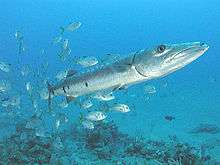
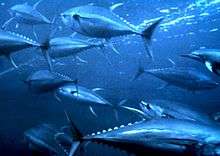

.png)
